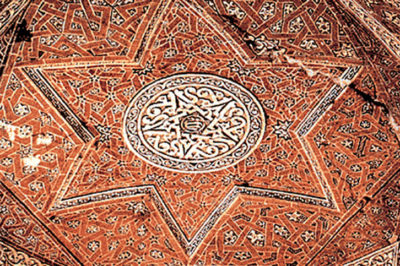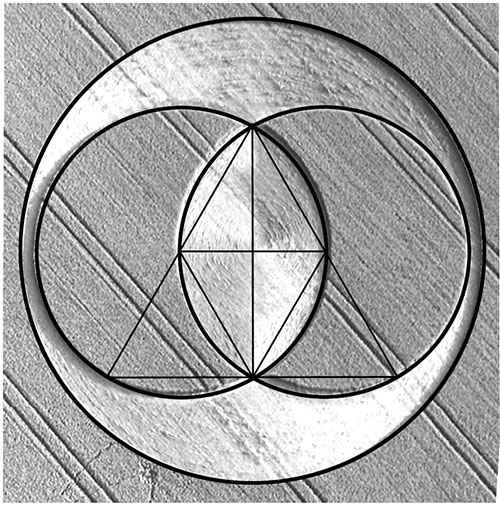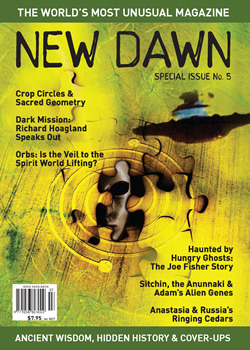From New Dawn Special Issue 5 (May 2008)
Know, oh, brother…, that the study of sensible geometry leads to skill in all practical arts, while the study of intelligible geometry leads to skill in the intellectual arts because this science is one of the gates through which we move to the knowledge of the essence of the soul, and that is the root of all knowledge.
– from the Rasa’il by the Brotherhood of Purity, translated by S.H. Nasr
Our experience and our reaction to all things beautiful is made possible by our unique ability to subconsciously recognise geometric order from transitory chaos. At this level, the perfection inherent in a Greek temple or a painting by Da Vinci is not simply because it is made of a particular material or hue but because the harmonic proportions contained in their design are bound by the laws of sacred geometry, which is itself the embodiment of harmonic waves of energy, melody and universal proportion. What our senses respond to is the geometrical and proportional harmonies and wave forms created through the application of sacred geometry.
As stated in Islam, and echoed in all Abrahamic and Hindu religions, sacred geometry provides the means to see the vestiges of God and Its multiplicity in the universal order of things. Remarkably, Islam still contains at its core one of the last unadulterated vestiges of primordial truth. Its mosques and art forms, as well as its latter-day architecture still incorporate many of the keys to the structure of the cosmos, symbols of the archetypal world as a creation of God.
Indeed, intellectual Islam is to be commended for the way in which it has preserved a mathematical philosophy “akin to the Pythagorean-Platonic tradition of antiquity but in a totally sacred universe free of the nationalism and rationalism which finally stifled and destroyed the esoteric traditions of Greek intellectuality.” Therefore it is not by accident that we see in Islamic art the very symbols which reflect the heart of matter.
As the last of the universal revelations – or religions – it is important to note that Islam has served as the curator of sacred geometry rather than its originator. It’s not certain where the terrestrial origins of this knowledge stems from but its forms are evident throughout the yantras and mandalas of Hindu, Tibetan and Buddhist art, Celtic carvings and book adornment, even in native North American sand paintings.

The earliest known proprietors of sacred geometry were the Egyptians who embedded its secrets in the ground plans of their temples, their frescoes and, most blatantly, in the Giza pyramid which single-handedly contains most of the fundamental universal laws that many a tortured schoolchild now attributes to Pythagoras. Although these enlightened people used geometry for all manner of terrestrial applications – hence the word ’geo-metry’ or ’measure of the earth’ – the aim was metaphysical in nature.
Because sacred geometry reflected the universe, its pure forms and dynamic equilibriums shared a higher purpose: the attainment of spiritual wholeness through self-reflection, thereby giving structural insight into the workings of the inner self. In other words, a way for the intuitive mind to find a reason for its existence: by journeying inwards, away from the three-dimensional world and towards fewer and more comprehensive ideas and principles.
As the renowned geometer Robert Lawlor observes, “the implicit goal of this education was to enable the mind to become a channel through which the ’earth’ (the level of manifested form) could receive the abstract, cosmic life of the heavens. The practice of geometry was an approach to the way in which the universe is ordered and sustained. Geometric diagrams can be contemplated as still moments revealing a continuous, timeless, universal action generally hidden from our sensory perception. Thus a seemingly common mathematical activity can become a discipline for intellectual and spiritual insight.”
As a mirror of the heavens sacred geometry was liberally applied across the Egyptian landscape for millennia as a way to bestow universal order on Earth, as reflected in their Hermetic maxim ’As Above, So Below’.
Consequently the practice of maintaining concrete records of this knowledge for posterity was reenacted throughout Europe in fabulous structures such as Chartres cathedral, one of the most impressive hymns to sacred geometry, and whose dissection alone has filled entire books.
That this knowledge made its way as far north as the British Isles can be clearly seen in the ground plans and blueprints of megalithic monuments, mediaeval cathedrals, and the plethora of stone circles. It is clear, therefore, that whatever lies behind sacred geometry was important enough for scholars to go to enormous lengths to preserve it for future generations.
With the advent of X-ray photography science has discovered that the physical structure of elements are governed by a patterned array of intervals surrounding a central node. The general assumption that the nature of matter is fundamentally composed of particles is rapidly giving way to the concept that the underlying patterns of the material world are geometric wave forms. The irony here is that by choosing to examine reality through geometry many ancient cultures find themselves close to the stance now adopted by modern science, and vice versa.
Little wonder, then, that sacred geometry was so important to the temple builders. And since the universe was created by God it theoretically followed that to embed physical structures with the ratios of creation the universe could be mirrored. In so doing, temples became doorways into the inner workings of the physical world and the inner world of consciousness. This interface would enable anyone so predisposed to integrate oneself with the gods.
Sadly, as these temples have fallen by the wayside so too has our wonder of the unseen and our connection to it, presumably why the very fabric of our present society lies rudderless and bankrupt.
There are several major events which have led us to this sad reversal of thought. As Robert Lawlor understands it, “modern thought has difficult access to the concept of the archetypal because European languages require that verbs or action words be associated with nouns. We therefore have no linguistic forms with which to imagine a process or activity that has no material carrier.”
The Renaissance saw the last great works based on sacred geometry which had been kept alive via Plato, and philosophies that survived suppression by the emerging Catholic Church. With the implementation of the Inquisition, the rise in secularism and a general move toward a rational and analytical view of the world, connections to holistic and metaphysical practices were severed. By the time Newton and the scientific secularism of the 17th century prevailed rational logic had gained such a dominance that all esoteric knowledge was inevitably condemned as occult (literal meaning, ’that which is hidden’).
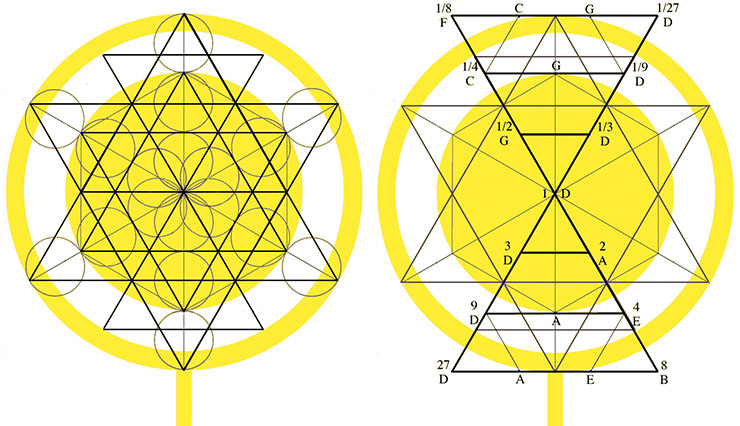
Connecting Sacred Geometry & Crop Circles
It is significant that as our alienation from all forms of spiritual and universal wonder increases, symbols bearing the hallmarks of an ancient, harmonious philosophy have suddenly begun manifesting in cereal crop.
Even to the hardened sceptic crop circle designs reveal a facility by their makers of creating a visual harmony that is pleasing to the eye, much like an ancient temple or a classical painting. The proportions are balanced, the shapes rhythmic, their outlying elements forming part of an unseen whole. Upon close scrutiny even the small ’grapeshot’ circles that flank certain formations lie at their given remote locations not by fluke but by engineered and premeditated design, markers and clues for the observer to follow and uncover. Not surprising, then, to find sacred geometry lying at the heart of the fundamental blueprints of many formations, sometimes blatantly, sometimes veiled like a secret waiting to be uncovered only by the most persistent of minds.
But just as with sacred geometry and other esoteric principles, crop circles have been marginalised by practically the entire scientific community since they challenge the current worldview simply because science is at odds to explain them.
According to science, crop circles don’t exist.
Yet, as these examples demonstrate, crop circles, through their complicated geometric structure, are worthy of being ranked alongside the greatest creations of mankind. Perhaps even higher.
When analysing crop circle forms through the precise and unalterable practice of sacred geometry one cannot help but appreciate that a mind of scholarly intelligence is involved, just as the great masters of Islamic and Egyptian art, as Keith Critchlow remarked, “were motivated by and versed in spiritual disciplines that gave content and meaning to their work and placed it in the tradition of aiding the viewer to raising his or her spiritual understanding.”
That these symbols are occurring primarily in wheat, the very symbol of the Earth Mother, is significant in itself. Perhaps they are here to draw us as a race together by this interaction with our symbol of life? Maybe their geometric symbolism acts as a mandala which like its Buddhist counterpart contains the very vibrations that aid one in achieving inner transformation at this most vulnerable moment in our history?
If neither of these apply then what we have strewn in fields across the world is nothing more than the highest form of cosmic art. Perhaps all of the above are true, and perhaps other explanations remain elusive. But one thing is certain – it is a lot of trouble for a bunch of individuals to go to, turning out during every night of the English summer for a quarter of a century, wading through muddy fields, and working with a brittle and imprecise canvas just to show the world they simply remained conscious throughout geometry lessons!
In the selected range of crop circle designs we see recurring themes that are for the most part generated from within a circular form and continue, through proportional expansion, to develop well beyond the boundaries of the design. This is consistent with the principle of sacred geometry where the circle is the principal element since it lies at the heart of the creative principle. It’s the representation of cosmic life, from the smallest atom to the largest planet. All things are divided from within itself so, paradoxically, all things are contained within it. It is therefore the symbol of the unknowable, of spirit and of heaven.
The symbolic opposite of the circle is the square which is considered material and of the earth. Both forms, when given equal areas and superimposed, become a symbol of the fusion between humanity and the universe, of spirit and matter. It is the first symbol and the one on whose proportions whole cosmological cities were founded.
The division of the circle into two equal size circles, with the centres of their respective circumferences touching each other, gives birth to an overlapping figure of profound symbolism: the vesica piscis. It is from within its vagina-like centre that the symbols of sacred geometry are born.
From the vesica we can create the simplest of polygons, the equilateral triangle. The two triangles contained in this ’womb’ are themselves symbolic of the world above and the world below, just as the left circle can represent spirit and the right one matter. It is symbolic to Christianity as representational of Jesus Christ and the Piscean age; as the Holy of Holies it carries the number 2368 in gematria, the number also equated with Jesus Christ.
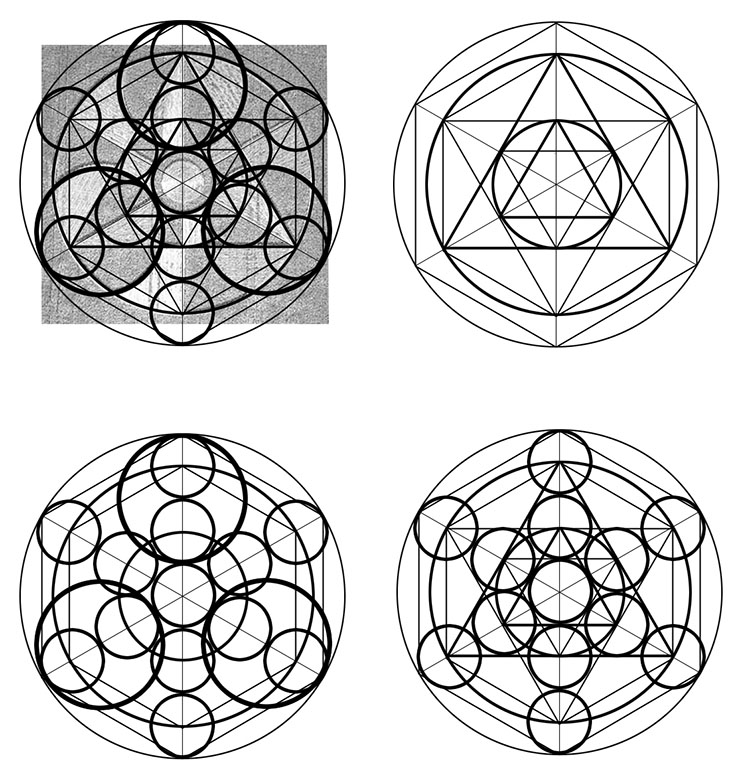
The overlapping of both triangles produces the hexagon, also referred to as the Star of David. The characteristics and symbolism behind this figure are immense. It is also through the natural division of a circle into six parts which allows six circles to fit exactly around the circumference of an equal seventh. John Michell has studied the implications of the hexagon at length and further adds that it is “symbolic of the order of the universe in the fact that twelve equal spheres can be placed around a thirteenth so that each touches the nucleus and four of its neighbours, producing the geometer’s image of twelve disciples grouped around the master. Christ, Osiris and Mohammed are among those who are represented as a central sphere with twelve retainers.” It is also a common symbol in Islamic geometry, and its qualities are rational and solar, as evidenced by its 6×60-degree triangles which reflect the solar number 666.
Another symbol of great fascination to ancient and modern geometers is the golden mean since it gives rise to a spiral form which occurs in many natural forms and patterns of plant growth which, as Michell points out, “gives support to the tenet of traditional philosophy that number preceded creation and determined its development.”
It is from the golden mean that we also extrapolate the pentagon and the five-pointed star, and with it the association with humanity since the human figure with outstretched limbs is similar to the pentagram. This was the symbol of the Pythagorean’s humanistic science and consequently worn as a talisman of good health. Its symbolism frequently pervades native American philosophy, just as Christians associated the pentagram with Jesus. The pentagon is lunar and psychic; the angle between two sides of a pentagon is 108 degrees, 1080 being the characteristic lunar number.
These primary geometric forms, along with their 3-dimensional counterparts, the Platonic solids, were thus observed by many ancient cultures to be the crystallisations of the creative thoughts of God as they emerge from the circular Unity. As a metaphor of universal order, sacred geometry is pervasive in imagery throughout history, from circular mandalas to sacred temples. And now, crop circles.
It is interesting that today we find ourselves at the final crossroads in our evolution. Since that day when we decided to abandon our faith in the universal way and follow the mechanical codes of science our consciousness has shifted from one of reverence for all things sacred to the worship of abstract materialism. Consequently, our change of attitude has endangered our living, breathing celestial sphere and it’s perhaps why crop circles, with their foundations based squarely upon sacred geometry, have chosen to appear at this particular point in time, reminding us that if only we observe the fundamental laws of the universe we may still be in time to discover the secrets of universal harmony and salvage our very own symbol of eternal life, the Earth.
Excerpted with permission from Freddy Silva’s book Secrets in the Fields.
© New Dawn Magazine and the respective author.
For our reproduction notice, click here.

